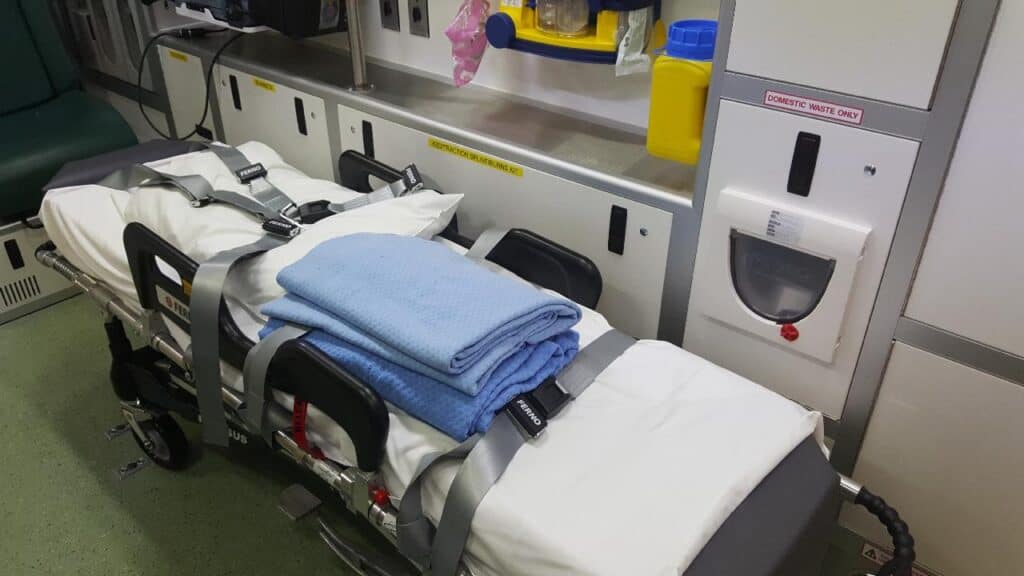We are most likely going to always need EMTs. EMTs are the first responders to emergency medical scenes, and they make decisions and offer aid that can make the difference between life and death. But how do you go about learning to be an EMT and getting your first step on the ladder of emergency response?
To become an Emergency Medical Technician (EMT), you must complete an approved EMT training program followed by a cognitive and a practical certification exam. These programs can be found at local community colleges and technical schools. They usually take about 6 months to complete, though some can be faster.
The process is not as time-consuming as it is in many other professions and it’s not particularly expensive. Here’s what you need to know.
Your # 1 priority is keeping your family safe. As a firefighter, I recommend everyone has updated smoke detectors that don’t require battery changes, like these ones from Kidde, a fire extinguisher, like this one from Amerex, and a fire escape ladder if you have bedrooms above the first floor, I recommend this one from Hausse.
Also read: What Jobs Can You Get With An EMT Certification? 11 Jobs
How To Become An EMT

Emergency medical services (EMS) play an enormous part in American life. Each year, around 25-30 million Americans will benefit from their services.
The role of the EMT is to head up much of the initial effort to provide emergency medical care and to be able to pass on that care to other professionals as needed.
An EMT is a first responder to an emergency situation, and they might have to deal with many different duties as part of that role; doing everything from driving an ambulance, to treating a patient for shock, to giving someone CPR or helping to wrap a broken bone.
That means EMT training is an essential part of the process of becoming certified because an EMT must be confident and capable of dealing with all of these situations in the best manner possible and to ensure the best patient outcome.
So, the basic steps of becoming an EMT are as follows:
- You must meet the basic requirements of an EMT particularly the educational requirement. You won’t need a degree to study for an EMT basic or intermediate course but, you may need a degree if you wish to push your career beyond the EMT level. You will certainly need either a full high school diploma or a General Education Development exam (GED) pass. If you haven’t done this, you will need to prior to moving forward with your desire to be an EMT.
- You must have a CPR certification. The vast majority of EMT courses expect you to arrive with the capability of giving basic CPR to a patient. The good news is that this certification is neither expensive nor time consuming to get and you can find local and online providers easily. If you’re not sure where to start, we’d recommend that you contact either the American Heart Association or the American Red Cross to learn about their training options – that way your training can support their charitable and community objectives.
- You must find an EMT program and join it. It’s easy to find an EMT program near you (and there’s no need to travel and enroll in a long-distance program) and the Commission for Accreditation of Allied Health Education Programs (CAAHEP) has a database you can search to find a fully accredited legit EMT program in your state. Typical providers of these programs include community colleges, trade schools and even emergency care specialist training programs.
- You must pass the EMT cognitive exam. This test is considered to be very challenging, and it is administered by the National Registry Emergency Medical Technician (NREMT) body. It can consist of as few as 60 or as many as 110 questions that cover all the main areas of EMS work. You must pass this test to continue your efforts to become an EMT. If you fail it, you will be given the opportunity to retake the test. If you fail too many times, you may be required to do some remedial training before taking the test again. If you continue to fail, you may be required to do the whole EMT course again if you wish to continue your attempts to become an EMT!
- You have to pass the EMT psychomotor exam. This is the practical exam that shows you are competent in a range of emergency skills and their use. It can involve everything from managing a cardiac arrest to setting a fracture to mouth-to-mouth technique. If you want to know exactly what could be on this test, you need to talk to someone at your state’s EMS office (they can also tell you the local pass mark for the test).
Also read: Is The EMT State Exam/Test (NREMT) Hard To Pass?
How Many Hours Is EMT Training And Certification?
There are 3 basic levels of EMT qualification: EMT Basic, EMT Advanced, and EMT Paramedic.
The basic qualification typically requires 120 hours of training plus independent study of your own before you are ready to sit the examinations.
The advanced training requires all the training of the basic level plus an additional 350 hours (or so) of formal training plus independent study of your own.
Paramedic training requires an additional 1200 to 1800 hours of education and training. This program will usually take at least another year to complete after EMT Basic.
Also read: How Long Does It Take to Become an EMT?
How To Pass EMT Class/School
EMT school is serious business and passing EMT school depends on you and the efforts that you put in.
You can improve your chances of success by following some simple tips:
- Attend all your classes. You’d be amazed at how hard it is to learn something when you’re not present for it being taught.
- Read your course books. Again, the more you expose yourself to information, the more likely it is you’ll take it in. That’s why they have a book.
- Do the course exercises. I know, it’s starting to sound like a broken record, right? But you have to do the exercise if you want to learn the info.
- Use test simulation software. This is a great way of getting some practice on the test under exam conditions.
- Have a study schedule. Stick to it. Writing a schedule is a nice start but unless you actually stick to it and ensure that you prioritize your EMT learning, you’re going to find life gets hard fast. You don’t have to study for days at a time, but you do need to make room for regular study sessions that allow you to constantly refresh all the things you’re learning in your head.
- Set an objective for each study session. Aimlessly leafing through textbooks is not studying. Having goals and a purpose for your session means that you can identify when you’ve done enough work and, over time, show progress towards the examinations at the end of the course.
- Know when you’re at your limits. A lot of people will try to study for long sessions when they get started and then, quickly, find themselves failing to get to the end of them and then they begin to panic that they’re not doing enough. Don’t do that. Learn how long you can study for, effectively, and then limit your sessions to that.
- Start with the most challenging work in each session. It’s better to do the things you find hard when you have the most energy and concentration. Leave the stuff you already know to the end.
- Learn to make good notes. Your notes shouldn’t be parrot fashion copies of your lecturer or tutor, they should be your own words that explain things in a way you relate to. This makes learning from them easy.
- Summarize your learning each day. Take a sheet of paper. And then put down a list of bullet points that you learned at the end of each day or each session. This will help you later when you want to make sure you’re studying everything that you’ve learned.
- Know the end result. EMTs are not meant to be walking medical dictionaries full of interesting facts, they’re meant to be able to hit the ground running and make decisions that benefit patients. If you study with this in mind, you won’t spend as much time trying to rote learn facts, because you can see the bigger picture.
- Rote learning is still useful. Sometimes, there’s just no avoiding the need to learn a big list of facts. When that happens – read them out loud. Yes, that might feel a little embarrassing, but it’s proven to really boost your retention of data. Though, it’s best not handled in the library.
- Use scenarios to make information meaningful. Take your notes and then try and ask, “How would this be useful in the real world?” Imagine patient scenarios and how you might put this learning into practice. The more of this you do, the easier it is to make the tough calls in real life.
- Don’t worry about grades. Seriously, the end result of this is pass/fail anyway. So, focus your efforts on learning and using the material you have. Don’t waste your time focusing on extra percentages. If you do this, you’ll get the best possible marks anyway and you’ll be nowhere near as stressed about learning.
- Work with others. One big advantage of creating a study group or partnering up with a peer is that you’ll all hold each other accountable. It’s easier to show up and get the work done with a bit of company. It’s also super helpful if someone gets stuck, they can seek input from the people around them to get moving again.
- Explain what you know to others. The most effective way to learn anything is to think about how you can explain that learning to other people. If you don’t have other people to do this with, pretend you’re explaining to a small child. Break down complicated ideas into their simplest form. This will really boost your marks come examination day.
- Do practice exams. Practice exams are super useful tools for getting comfortable with the tests to come. Make sure to use exams that are in the same format as your state’s testing board will use, you really don’t want to turn up on the day and find you’re sitting an unfamiliar exam process or content.
- Don’t be afraid to make diagrams, pictures and other learning aids. The more you rework what you know into other forms, the easier it is to remember what you know. Draw pictures, mind maps, flow charts, pie charts, whatever it takes to help you break down information. Then make decision trees for complicated processes.
- Never be afraid to ask for help. You’re not expected to be the perfect EMT when you’re learning, you’re expected to learn and to need help. If you get stuck talk to your teachers, your peers, or even pick up the phone and call someone in the profession (at a convenient time) to get their input.
Also read: The Difficulty of EMT School: Is It That Hard to Pass?
How Much Does EMT School Cost?
The good news is that it’s not a huge expense to become an EMT basic and you shouldn’t expect to spend much more than $1,000 to $2000 for the course and it can be much less depending on your location in the country and the learning provider that you choose.
You will also need to pay for tuition, certification, a TB (Tuberculosis) exam, and if you haven’t already got it, CPR training from a CPR training provider.
This won’t come to much more than an extra $300-$500 depending on your exact needs and location and education provider.
Also read: How Much Does It Cost To Become An EMT or Paramedic?
Do EMTS Get Paid Well?
No, in fact, an EMT basic can’t command a very high salary at all, after all, their training is short and inexpensive, which means there aren’t very high barriers to entry or qualification.
However, that does not mean that an EMT cannot be paid well and, in fact, very few EMTs remain as basic EMTs throughout their career many more will use an EMT certification as a stepping stone to another higher paid role.
Many firefighters, paramedics, nurses, doctors, and more have all started with EMT basic certifications and then developed themselves to the point of having a well-paid role in society.
Also read: Do Firefighters Have to Be Paramedics or EMTs?
Can Live Off Being An EMT?
Yes, you can live off an EMT wage, but it’s not easy to do and it’s one of the reasons that most EMTs will look to further develop their career.
With an annual wage of around $33,000, an EMT is earning less than the national average.
Also read: Can You Live Off an EMT or Paramedic Salary? $$$
Is Becoming An EMT Worth It?
If you mean “worth it” in financial terms? No, it’s fair to say there are much better-paid positions in this world than EMTs.
If, on the other hand, you mean “worth it” in terms of personal and spiritual fulfillment? It absolutely is worth it to become an EMT.
Is EMT A Good Career?
If you use EMT as a stepping stone in a larger career, it is a fantastic career choice with many options opening up as you become more qualified and successful.
If, on the other hand, you intend to remain an EMT, that’s going to be a rather more personal decision as to whether it makes you happy or not.
Also read: Is EMT a Good Job/Career? Is it Worth It?
What’s The Difference Between An EMT And A Paramedic?
A paramedic is also a first responder but one which is qualified to a higher level than an EMT. Typically, paramedics conduct an extra 2+ years of training and they assume more responsibility in the field and are better paid than regular EMTs.
Also read: What is a Firefighter Paramedic? The Job Explained
Are All Firefighters EMTS?
At the moment, not all firefighters are EMTs but, the vast majority of firefighters in the US are. As the fire service comes to terms with better construction standards and safety standards, it has fewer and fewer fires to fight.
Thus, firefighters are becoming increasingly multi-skilled and are being used as first responders to emergency medical incidents when they are not fighting fires.
Most new firefighter vacancies will require, at a minimum, for a firefighter to hold an EMT basic certificate now and many more require an advanced or even paramedic certification too.
Sources:
Related Articles
What Shifts Do EMTs/Paramedics Work? Schedules Examined

